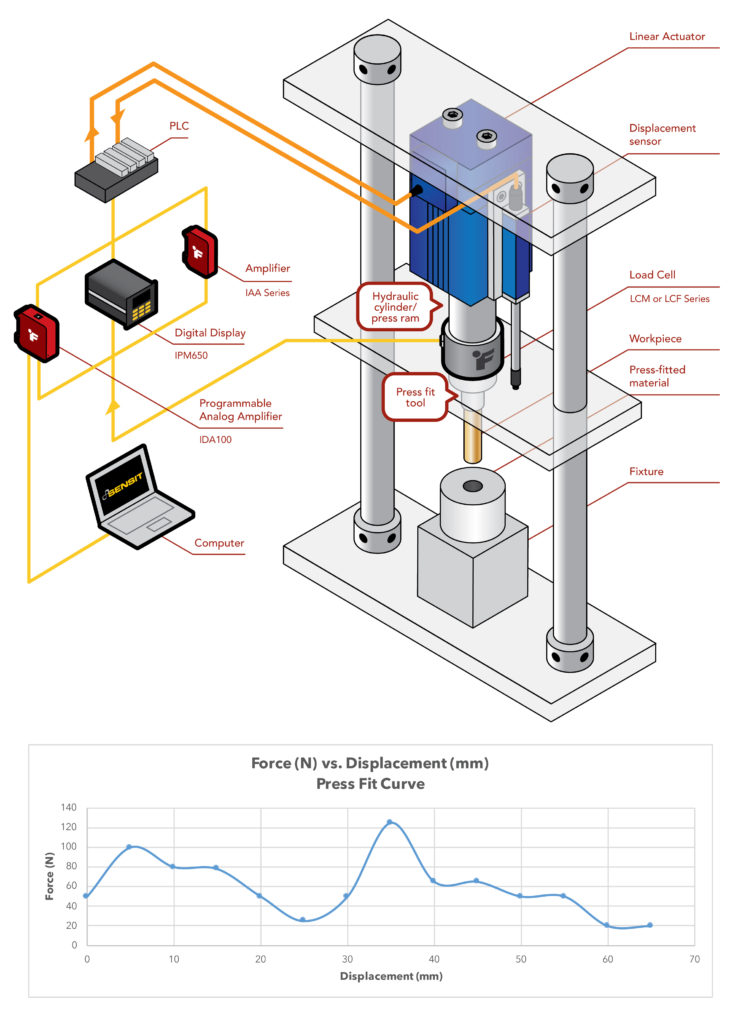This application note on Determining Press Fit Force Assembly was provided by our friends at FUTEK. To view the original application note, click here.
So, what is Press Fit Force?
Firstly, Press Fit is also known as Force Fit or Interference Fit. So, what is it? You may ask. It is an assembly of two parts mounted tightly through normal force or friction. A good example is when a shaft is inserted tightly into a slightly smaller hole, with the interference holding both parts in place. The inserted part is usually 0.0254mm to 0.0508mm larger than the mating hole.
The parts may be assembled using a hydraulic cylinder as highlighted on this application note. However, to avoid damage during joining, some critical components may be shrunk. This is achieved by cooling those components significantly below room temperature before fitting. Electric and Pneumatic press-fit assembly types can be retrofitted using FUTEK sensors.
Where is Press Fit Used?
Press fit technology is used in the manufacturing of electronic and electromechanical components. Parts that are assembled with press fits include: bush rings, bearings, studs, pins, rotors, gears, pulleys and shaft collars. By using Press Fit technology, manufacturers create high reliable electromechanical interconnects without the use of solder.
According to manufacturing industry experts, if the components are correctly designed, press fitting is the least expensive assembly method. This is in comparison to soldering, fastening, or gluing.
Why is it important to monitor press fit force?
Press fit is becoming more widely used assembly method. However, it becomes challenging to inspect press fit defects. This is because work piece dimensions are shrinking, and placement density are increasing.
Therefore, press fit force monitoring systems are implemented. These systems are designed to recognise defects and perform real time analysis to continuously improve manufacturing and achieve higher press fit assembly productivity.
Common Quality Issues in press force applications:
Part Issues
- Incorrect Orientation
- Oversize or undersize parts
- Improper Insertion
Machine Issues
- Bad Alignment
- Wrong RAM speed
- Loose Fixtures
- Low Hydraulic / Pneumatic Pressure
Use FUTEK Load Cell Sensors in your Press-Fit Force Monitoring System
Therefore, the solution is a press-fit force monitoring system that ensures that the press-fit assembly process is monitored properly and quality issues are caught in real time. FUTEK’s Load cell sensors are ideal for these applications. This is because they output extremely accurate results through millions of assembly cycles.
A press fit operation station can be equipped with a displacement transducer. The transducer is used to measure the movement of the press ram during the operation. Data captured by these two sensors, force and displacement sensors provides a force-displacement measurement for press fit feature check: Force vs Time, Distance vs Time, and Force vs Distance.
How it Works
- Firstly, a LCF300 Universal Pancake Load Cell is mated between a linear actuator piston and the press fit tool
- Secondly, as the hydraulic or electric cylinder (aka hydraulic ram) press fit the work piece (ie shaft) into the press fitted material (ie. Hole) the LF 300 measures the press fit force applied.
- The force measurement signal from the LCF300is sent to the digital display (IHH500 or IPM65) or any of FUTEK signal conditioners (IDA100 or USB520). The signal is displayed on a PC using FUTEK’s SENSIT™ force measurement software.
- Finally, an amplified analog signal is sent to the PLC controlling the hydraulic or pneumatics press. This will enable the ability to act on defects and quality issues in the press fit assembly in real time.
- Additionally, SENSIT software can be used to log sensor output for quality control purposes.
Products Used
- LCF300: Universal Pancake Load Cell
- IAA Series: Strain Gauge Analog Amplifier with Voltage Output
- IPM650: Panel Mount Display
- IDA100: Strain Gauge Amplifier with Digital and Analog Output
